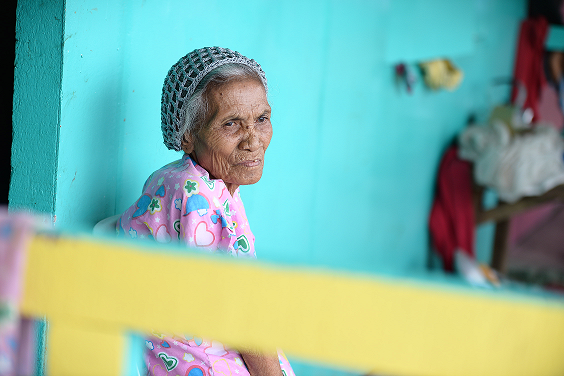
"Untagged" but not forgotten: Home-based Internally Displaced Persons (IDPs) in Zamboanga
Home-based IDPs are people who have been forced to flee their homes to avoid the effects of armed conflict, generalized violence, violations of human rights or natural or human-caused disasters, but are staying with relatives or friends. Since the September 2013 conflict in Zamboanga, which initially displaced an estimated 120,000 people and damaged about 10,000 homes, there are still 1,473 families who are residing with families or relatives and not in evacuation centres or transitory sites. Some of these IDPs are not registered with the government and have been designated as “untagged” by the city’s social welfare and development office. They receive little or no humanitarian assistance and are often left out of the resettlement programme.
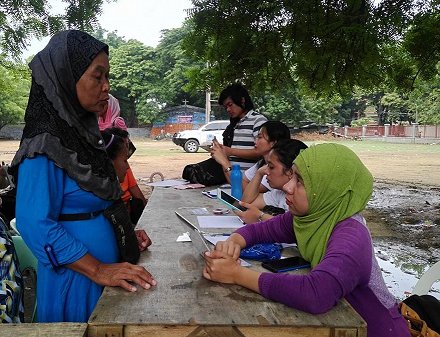
A home-based IDPs’ struggle after the siege
Mariame, a mother of three children, recalls the morning of 9 September 2013 when fighting broke out near her home in Barangay Sta. Catalina in Zamboanga City when Moro National Liberation Front fighters stormed the city. That morning she intended to take her daughter to school but ended up fleeing to Barangay Tetuan to stay with her sister. Her husband had left early that morning for work at a lending company in the city centre. Before the conflict, she sold fresh food and vegetables. The fighting engulfed five barangays of the city. “My house was one of those burnt down by the conflict,” say Mariame.
After one year, Mariame ended up in the Tulungatung transitional shelter. She received assistance from the Department of Social Welfare and Development (DSWD), Community and Family Services International (CFSI) and other humanitarian organizations to get her life together. “The siege disrupted my family’s life and created a new way of existence that’s full of challenges. I was not registered as an IDP because I stayed with my sister and was designated instead as ‘untagged’. We missed out on the assistance provided to others. However, I was lucky to be selected to benefit from a CFSI livelihood support programme and received training in sewing and tailoring. I now sew my daughter’s clothes and at the same time earn income as a dressmaker.”
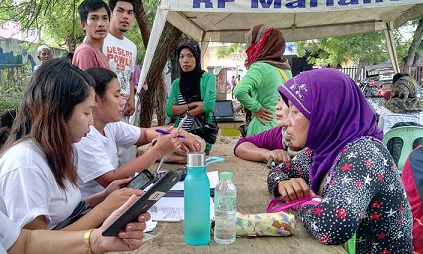
"Profiling IDPs" in Zamboanga City
In order to obtain better information on home-based IDPs, the United Nations High Commissioner for Refugees (UNHCR) in partnership with Zamboanga City Social Welfare and Development Office profiled homebased IDPs in July 2016. The survey reached 1,474 families, including those living with relatives, friends and other family members, or renting a house–those not in evacuation centres or transitory sites. About 23 per cent of these IDPs were “untagged”, so they do not benefit from programmes available at the shelters. The data indicate that the number of IDPs who were unemployed before the conflict has now doubled after conflict. Eighty per cent are from the Tausug community in Barangays Rio Hondo, Sta.Catalina, Sta.Barbara, Mariki and Talon Talon. About 27 per cent receive no form of assistance and a majority have expressed their wish to return to their original homes. Three years after the conflict, approximately 12,880 people remain displaced in Zamboanga City waiting for permanent housing and sustainable livelihoods.
Out of a targeted 6,500 permanent housing units, the National Housing Authority has completed about 4,000 but half are without electricity or functional plumbing. So far, only 1,850 housing units have been awarded to families. The majority of the displaced people remain in transitory sites, which are now deteriorating. A site designated for 3,000 permanent housing units in Barangay Kasanyangan currently has no access road. The local housing division of the city reported that the Local Water Utilities Administration in Manila has not transferred P527 million (US$10.9 million) to the City’s Water District under the Zamboanga Roadmap to Recovery and Reconstruction (Z3R) project.
To better understand the needs of people displaced multiple times and build a common vision on how to tackle them, OCHA is undertaking a study on protracted displacement globally.
Update on IDPs in Mindanao island provinces
The number of people displaced is likely to increase as fighting in the island provinces of Sulu and Basilan between Government forces and the non-state armed organization, Abu Sayyaf Group, continues. An estimated 10,000 people have been displaced since August 2016. Women and children fleeing their homes are reportedly traveling to Zamboanga City for safety. Security risks have hindered the response of humanitarian actors to effectively access and assist displaced people in the region. Central Mindanao, in particular Maguindanao and North Cotabato provinces, is also affected by repeated displacement due to conflict between Government forces and the Bangsamoro Islamic Freedom Fighters armed group.
Global study on protracted internal displacement
To better understand the needs of people displaced multiple times and build a common vision on how to tackle them, OCHA is undertaking a study on protracted displacement globally. Dr. Walter Kaelin, a renowned expert in the field of protection and internal displacement issues, will be undertaking field visits to the Democratic Republic of Congo, Ukraine and the Philippines to gather information.
Efforts to find effective responses to protracted internal displacement have been hampered by the lack of a comprehensive understanding about how protracted displacement impacts internally displaced persons and the host communities, as well as the overall socioeconomic and political context in which IDPs live. There is also limited evidence on good practices and lessons learned from government and aid agencies’ previous and ongoing efforts that can effectively support IDPs to take steps that allow them to progressively improve their circumstances, with the ultimate objective of regaining a normal and dignified life.
The study is expected to clarify definitions of protracted internal displacement, and its global scale. The study will also identify good practices, and recommend measures for Government, humanitarian and development agencies to address the long-term impact of internal displacement in their policies and programmes.
Verifying grave child rights violations in armed conflict
On a warm Saturday morning, Jhun (not his real name), a young boy from an indigenous community in Northern Mindanao, had attended the wedding of his cousin and was waiting eagerly for the feast that would follow to begin. “I had just reached out to grab some rice off the table when my left hand was hit by a bullet,” he said. Jhun shows us his hand, permanently deformed by the gunfire.
According to several sources, seven heavily armed men dressed in military fatigues had descended on the wedding party, indiscriminately firing rounds from their automatic weapons. Jhun grabbed the hands of two smaller children next to him and fled for the river nearby, hoping to hide among the reeds.
In the chaos that ensued, a woman at least three months pregnant and carrying her 1 year-old infant on her hip was hit by gunfire while trying to escape. She and her unborn child died, but the infant survived.
The attack, which appears to have been perpetrated by a paramilitary group, continued for about 30 minutes before moving on to other communities in the tribe’s village. According to some community members, it was the most violent act yet in a years-long feud over the development of mining operations in the area, which the tribe opposed.
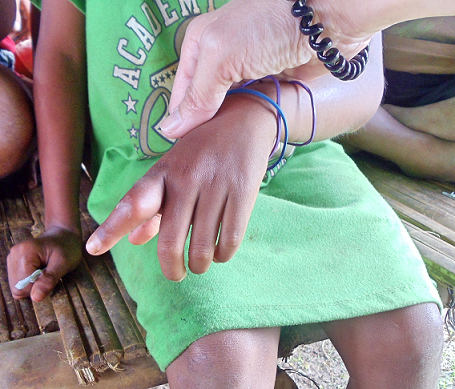
Data gathering and verifying process
OCHA joined the United Nations Childrens Fund (UNICEF) on this field mission to gather information regarding that incident and other alleged grave violations against children in situations of armed conflict.
A team under the Child Protection Section of UNICEF monitors six types of grave violations through the Monitoring and Reporting Mechanism on grave violations of children’s rights in situations of armed conflict: killing and maiming, recruitment and use of children, attacks on schools and hospitals, abduction, sexual violence and denial of humanitarian access.
The team reviews media stories and receives reports from government agencies, parties to conflict and non-governmental organizations (NGOs) in the field for incidents of grave violations against children allegedly perpetrated by the parties to conflict, armed forces and armed groups. They also rely on OCHA and other UN agencies operating in the field to provide information on grave child rights violations they come across in the course of their work.
Then the long process of tracking down original sources, witnesses, victims and survivors, who are often in remote areas with limited access to a telephone or other modes of communication, begins. Even then, not everyone, including the children, is willing to talk. The team travels frequently to places around the country and works closely with NGOs, government agencies and other relevant partners on the ground to coordinate interviews and meetings.
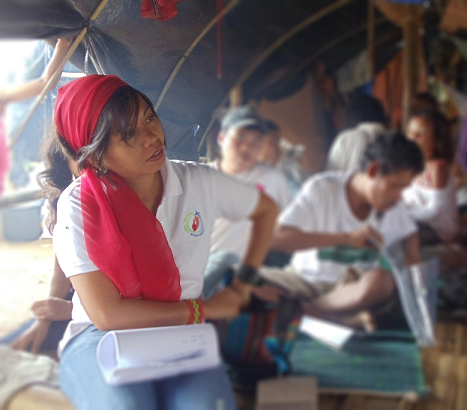
The information from this field mission will be shared and discussed in the quarterly meeting of the Country Task Force on Monitoring and Reporting, the UN-led body in charge of monitoring and reporting these incidents in the Philippines. UNICEF’s country office together with the UN Resident Coordinator’s Office leads the task force, which includes OCHA, UNHCR and the United Nations Population Fund (UNFPA) among its members. The team meets quarterly with the Government’s Monitoring, Reporting and Response Mechanism on Grave Child Rights Violation, chaired by the Council for the Welfare of Children, to ensure that adequate response takes place on cases of child rights violation and that perpetrators are held accountable.
The mission began with a meeting with the regional office of the Commission on Human Rights (CHR) to discuss specific cases as well as the actions taken by their office. The lack of human resources to investigate numerous cases and some administrative barriers, such as need for a birth certificate of victims, limit the impact of their work. Despite these difficulties, CHR shared that they manage to support victims of human rights violations and make sure that justice was meted.
The team also met with employees of the regional and provincial offices of the DSWD and the Provincial Health Office to follow up on assistance being provided to meet the needs of evacuees while they wait to return home. In addition to some assistance from the Government, local NGOs and faith-based groups have been helping the families and advocating for them.
Half a day was spent with the survivors of the attack who recounted the event. Jhun and his family are among about 200 members of the tribe who have been living in a camp they improvised in the capital city. They are afraid to return to their homes amid fears of renewed violence. Their descriptions are tinged with sorrow, fear, and anger, and they want justice.
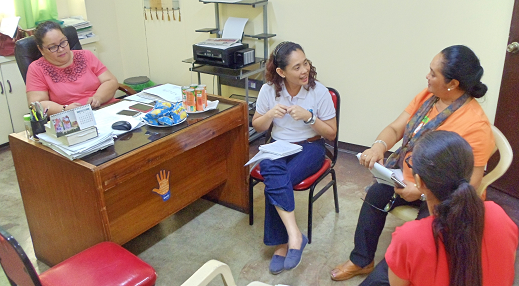
The leader of the evacuees in the camp described his appeals with the provincial government for basic necessities such as food, shelter and sanitation. He also demanded the perpetrators be apprehended within 60 days so they can return home safely.
Jhun’s story, unfortunately, is not uncommon. He is one of many children victimized by armed conflict in the Philippines annually. But, he is among the survivors and, as the team wrapped up our visit, went off to play with the other children in the camp.
UNICEF monitors six types of grave violations through the Monitoring and Reporting Mechanism: killing and maiming, recruitment and use of children, attacks on schools and hospitals, abduction, sexual violence and denial of humanitarian access.
They are afraid to return to their homes amid fears of renewed violence. Their descriptions are tinged with sorrow, fear, and anger, and they want justice.
Assessing the impact of recent conflict in Maguindanao
For 17 days in July, Government law enforcement operations against armed groups operating in the ‘SPMS box’-the adjoining towns of Shariff Aguak, Pagatin (Datu Saudi Ampatuan), Mamasapano and Shariff Saydona Mustapha in the province of
Maguindanao-displaced over 30,000 people. The encounter began on 12 July 2016 at the boundaries of Datu Unsay and Shariff Aguak and spread to neighboring Datu Saudi Ampatuan, Shariff Saydona Mustapha and Datu Salibo.
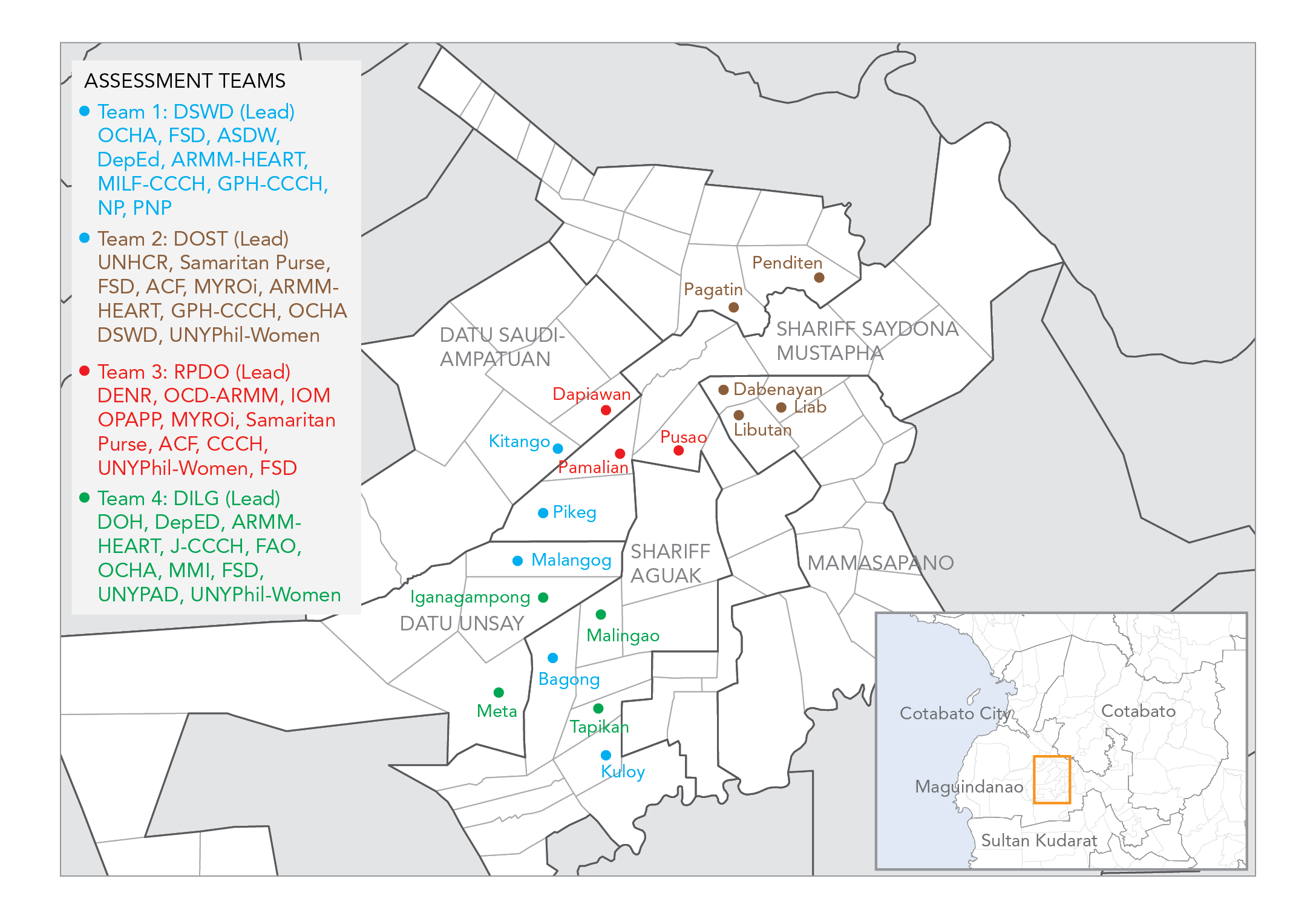
Highlights of the needs assessment
Four teams set out on 11-12 August to visit selected barangays in the affected areas. Many of the people they met are farmers, but there are areas where irrigation wells have gone dry. To make ends meet, some borrow money for their daily needs, while others work as day labourers or fish in the marshes. In spite of the long El Niño-induced drought, their rice fields remained productive, but not adequate to pull them out of the cycle of debt. Forced to evacuate because of the conflict, many returned home only to find missing livestock and other farm inputs, further disrupting their livelihoods and contributing to their food insecurity.
Some of the communities only use their wells for laundry and other domestic uses, while buying their drinking water. Still others rely on free-flowing underground springs and untreated well water for their drinking sources, putting them at risk for water-borne diseases. While most of the communities have water-sealed latrines in their homes, evacuees often have no other option than to defecate in open pits.
The assessment teams found remarkably little property damage from this military operation during their assessment. Still, the SPMS box has long been a hotbed for conflict, and the damages caused by previous incidents continue to impact families from completely returning to their homes.
Schools, day care centres and madrasahs were closed during the military operations, but the assessment teams found that most children were back in school in their own communities shortly after the military ceased its operations. Still, there were isolated reports of closed madrasahs, students transferring to other schools and others who were unable to continue their education due to financial reasons.
A need for medicine resonated across all areas visited by the assessment teams, but particularly in far-flung areas without community health stations nearby. Fever, coughs, colds and diarrhoea are the most common ailments to affect evacuees and especially children. One team was told of three evacuees who died from illnesses at an evacuation center.
The teams also learned from the people they interviewed that most lacked any food assistance during their evacuation. Only a handful of affected barangays were reached with food packs from local governments, ARMM HEART and ARMM’s Department of Social Welfare and Development. Moreover, many of the evacuation sites lacked communal cooking areas or even pots and utensils to cook with.
Fear and insecurity
The teams also found people did not have access to accurate and relevant information from community officials to help them decide whether or when it would be safe to return to their homes.
The July encounter was just the latest incident for many who were displaced, and fear of the next armed skirmish keeps them from permanently returning home. For those who did, finding their homes looted, armed actors occupying civilian buildings and unexploded ordnances abandoned in public places only aggravate their concern for their safety.
Mothers told the teams they feared for their children’s safety and worried about the disruption of their education or the separation of their families during evacuations. Other vulnerable groups, such as seniors and persons with disabilities, may not get the assistance they need during an evacuation. Civilians, including minors, are sometimes killed or injured as well, in these armed conflicts.
Displacement is common and people here are resilient, and while progress continues on the peace front, it may be a while yet before the residents of the SPMS box are able to sleep peacefully in their own beds.
Some of the communities only use their wells for laundry and other domestic uses, while buying their drinking water.
Still others rely on free- flowing underground springs and untreated well water for their drinking sources, putting them at risk for water-borne diseases.A need for medicine resonated across all areas visited by the assessment teams, but particularly in far- flung areas without community health stations nearby.
The LGBT community in Philippines humanitarian response
The lesbian, gay, bisexual and transgender (LGBT) movement in the Philippines has seen significant development in spite of many hurdles. Coined in the late 20th century to more accurately represent the diversity of the gay community, LGBT groups continue to advocate for their rights and for inclusion in the legal framework. In 2011, the UN Human Rights Council (HRC) adopted resolution 17/19, the first UN resolution on sexual orientation and gender identity. In a report by the Office of the United Nations High Commissioner for Human Rights (OHCHR) following the resolution, evidence of discrimination faced by people because of their sexual orientation or gender identity was presented including inequities in employment, access to health treatment, care and support and education, as well as criminalization, physical violence and murder.
In the Philippines, the LGBT community currently faces the challenge of advocating for inclusion within the country’s social, cultural and religious norms. It is in this landscape that humanitarian organizations seek to understand their needs and better assist them during an emergency response or recovery after a disaster.
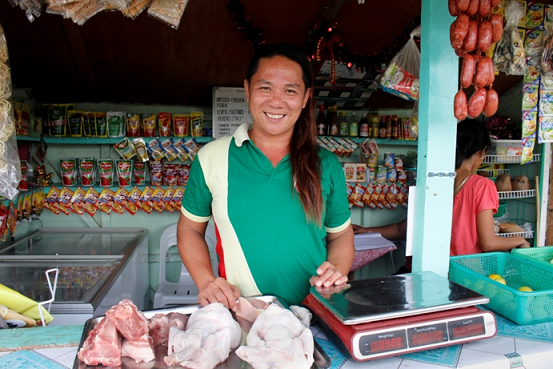
Oxfam and UNDP reports on the LGBT community in the Philippines
An Oxfam report, ‘Leaving No One Behind: LGBT Rights Post-Haiyan’, states that
the needs of LGBT people in communities remain noticeably unexpressed, especially during disaster response. The report follows individuals not only as internally displaced persons but as persons of a specific sexual orientation or gender identity. The report details that in temporary resettlement sites in the aftermath of Typhoon Haiyan (locally called Yolanda), LGBT displaced persons were subject to discriminatory comments,
had difficulty accessing sanitation facilities, and were excluded from disaster relief and
livelihood initiatives.
“The beneficiaries of livelihood projects are usually mothers, fathers, young women and young men, but never the LGBT sector,” says Arturo, a gay man living in a temporary resettlement site. He states that in a project involving the distribution of fish cages among men, “gay men were not chosen as beneficiaries even though guarding and feeding the fingerlings are tasks we are capable of. Nobody informed us about the project since the proponents wanted men.”
LGBT persons have yet to be recognized as a group with specific needs in community- based disaster risk reduction and management . The need for LGBT awareness in local communities has significant implications in nutrition and child protection. In the aftermath of Typhoon Ketsana (locally called Ondoy) in 2009, the Oxfam report states that in some communities, there was preference for non-gay children in the distribution of food within the family. They were only able to get more when their siblings had already eaten.
A report was released by UNDP and USAID in 2014 as part of the ‘Being LGBT in Asia’ initiative titled ‘Being LGBT in Asia: The Philippines Country Report, A Participatory Review and Analysis of the Legal and Social Environment for Lesbian, Gay, Bisexual and Transgender (LGBT) Individuals and Civil Society’. The report reviewed LGBT rights in the country including laws, policies, religion, and social attitudes. It noted that LGBT rights in the Philippines are not always supported by the state, and there is a need for LGBT Filipinos to access information regarding concepts of sexual orientation and gender identity, especially in rural areas.
The Oxfam report recommends that LGBT persons be recognized as stakeholders and as a distinct sector. LGBT organizations must be engaged in consultations as part of policy and decision-making processes around humanitarian work. Training and outreach on technical aspects of disaster risk reduction and management must be extended to the LGBT community. The report also recommends including sexual orientation and gender identity in data gathering, such as questions on marriage, partnerships and family, to ensure inclusive practices and benefits. Protection pathways must take into account the specific needs of LGBT persons, especially when they have children under their care or when they have medical conditions. An inclusive approach to sexual and reproductive health and rights must also be considered. Toilets, laundry areas and water sources, especially those for communal use, must be accessible and well-lit and provide total privacy.
Training on the protection of LGBT persons in forced displacement
UNHCR and the International Organization for Migration (IOM) have jointly developed a training package for staff members as well as the broader humanitarian community on the protection of LGBT persons in forced displacement. The training modules include terminology, international law, communication, international protection, resettlement and refugee status determination with a focus on practical guidance for humanitarian and protection actors.
Positive steps towards LGBT inclusion in the Philippines
According to the UNDP report, in the absence of national legislation, some local government ordinances mandate protection from discrimination on the basis of sexual orientation and gender identity. Quezon City, Angeles, Cebu, Bacolod and Davao
are some examples. In August 2012, the Philippine Judicial Academy partnered with government agencies from the United States to conduct focus groups that involved judges, court personnel, and representatives from the LGBT community in the Philippines to gather information about LGBT participants about the LGBT community to address gaps in laws, programs and resources. The output for this activity will serve as the basis for the training curriculum of the Awareness Enhancement Seminar on LGBT for selected judges in the Philippines. In May 2016, the first Filipino transgender politician was elected to the House of Representatives. Representative Geraldine Roman is co-author of the Anti-Sexual Orientation or Gender Identity Discrimination Act filed in June 2016.
Continued efforts to secure equal rights for the LGBT community
On 21 September 2016, UN Secretary-General Ban Ki-moon urged the international community to continue working for equal rights and fair treatment for LGBT people, reiterating the UN’s commitment to securing their human rights. To follow its 2011 resolution, the UN HRC in June 2016 adopted a resolution on the ‘Protection against violence and discrimination based on sexual orientation and gender identity’ and to mandate the appointment of a first-ever independent expert to monitor and report on violence against LGBT people.
LGBT persons have yet to be recognized as a group with specific needs in community-based disaster risk reduction and management.